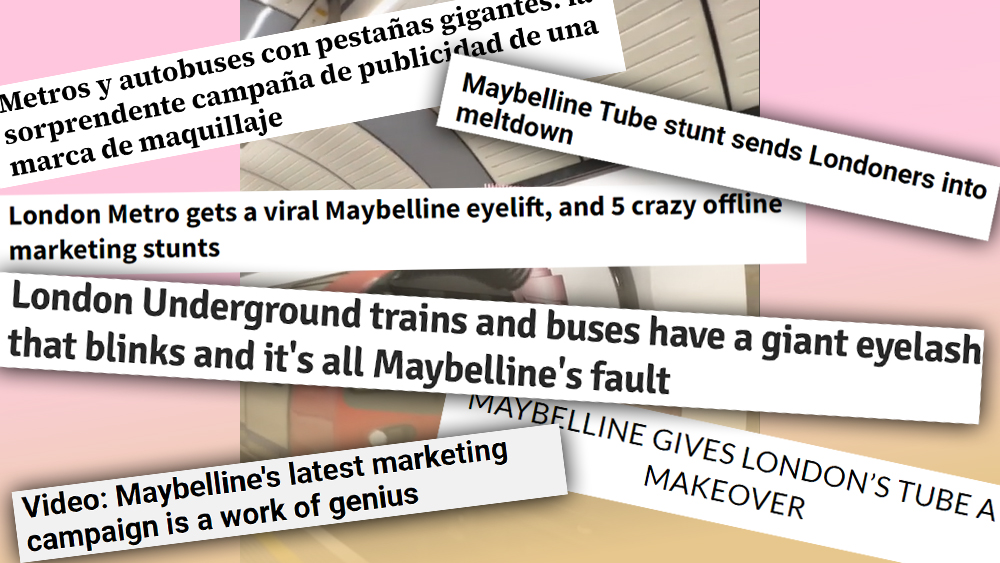Hold on, those clever Maybelline ads weren't real?

Maybelline had a viral hit on its hands last week with a TikTok video that appeared to show a clever out-of-home advertising campaign involving some glamorous public transport. Scores of national and international media outlets reported that the makeup brand had put eyelashes on London Tube trains and buses and erected giant mascara wands to give said lashes some extra volume at strategic stops. We almost published the news ourselves.
"I can’t believe they did this," people commented in amazement as they shared the stories. Only they didn't do it. The physical campaign didn't exist. The video was created using special effects. While it shows how easy it is to fool even traditional media it also raises a questions. Why are brands suddenly pretending to have carried out fake advertising campaigns? (see our pick of the best print adverts for our favourite real campaigns).
It's pretty easy to dupe people online these days. With the best AI image generators easily accessible, anyone can create an image of almost anything and post it to social media claiming that it's real (or not claiming anything but allowing people to believe it's real). What's strange is for a big brand to pretend to have conducted an advertising campaign. Surely that's a strange thing to make up when it isn't April Fools' Day?
And what does it communicate about the product? I mean, if Maybelline's adverts don't exist, do its products? Or is the idea that if it can make big fake fake eyelashes look like real fake eyelashes then perhaps it can make real eyelashes look like fake eyelashes... or something?
The writer Nick Asbury argues that part of the power of advertising is "costly signalling". He wrote on Twitter that "people think, if you can afford a giant 3D poster in Dubai, or a major collaboration with London Transport, you must be doing something right." And with modern technology, if you can't afford it (or if you can afford but don't think it's worth spending the time and money on), you can mock it up, post it online and chances are it will generate just as many likes, reposts and even headlines in traditional media. Most people will never realise that it wasn't real.
Much of the value of advertising comes from ‘costly signalling’ – people think, if you can afford a giant 3D poster in Dubai, or a major collaboration with London Transport, you must be doing something right. Adidas & Maybelline both play off that with CGI mock-ups... pic.twitter.com/Yn5keAYJTHJuly 13, 2023
Asbury notes that Maybelline isn't the only brand to have made a high-profile 'fake' advert recently. That giant 3D Adidas advert in Dubai after the World Cup was also fake, made to look like it was captured on video by a member of the public. Meanwhile, the creative studio Uncommon was criticised for posting a mocked-up extension of its British Airways billboard campaign made to look like it was at Glastonbury Festival. These are the kind of mockups that brands might make while designing a campaign, bu mockups are becoming the end product.
As Asbury says, there are implications for the places and other brands involved since we assume that Maybelline did not seek Transport for London's permission and that Glastonbury, a festival that long sought to protect itself from over-commercialisation, did not approve the fake British Airways ad despite the 'Glastonbury 2023 x British Airways' caption.
Daily design news, reviews, how-tos and more, as picked by the editors.
Asbury argues that advertising watchdogs will need to develop codes of practice for the use of CGI (and surely AI too). But it's a complex area. I'm not sure what layer of the onion skin we've added if we're being hit with advertising promoting fake advertising. It's as if some brands think the internet is now the Metaverse with only a tenuous connection to the physical world (time to start exploring the best AI art tutorials!).

Joe is a regular freelance journalist and editor at Creative Bloq. He writes news, features and buying guides and keeps track of the best equipment and software for creatives, from video editing programs to monitors and accessories. A veteran news writer and photographer, he now works as a project manager at the London and Buenos Aires-based design, production and branding agency Hermana Creatives. There he manages a team of designers, photographers and video editors who specialise in producing visual content and design assets for the hospitality sector. He also dances Argentine tango.

